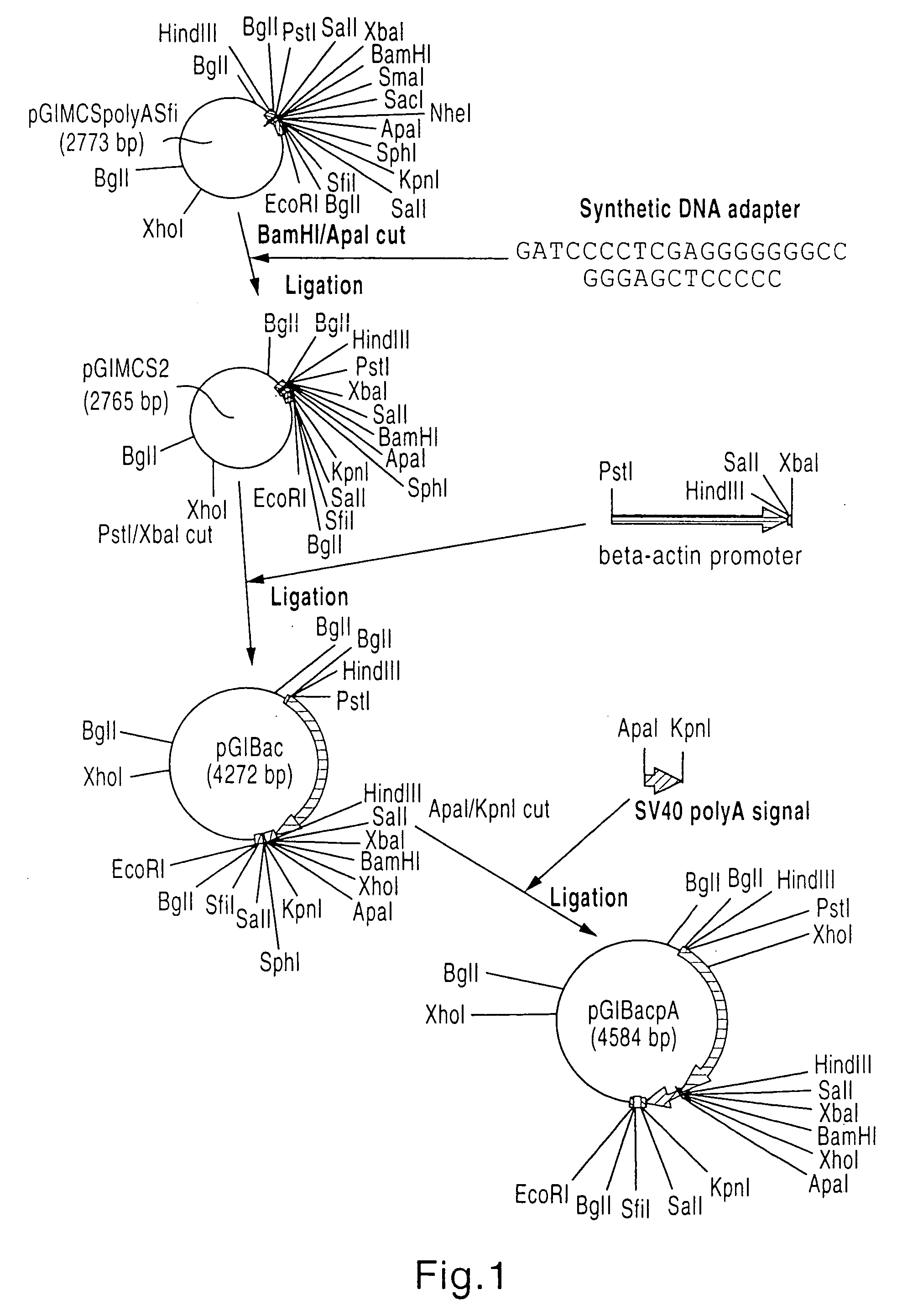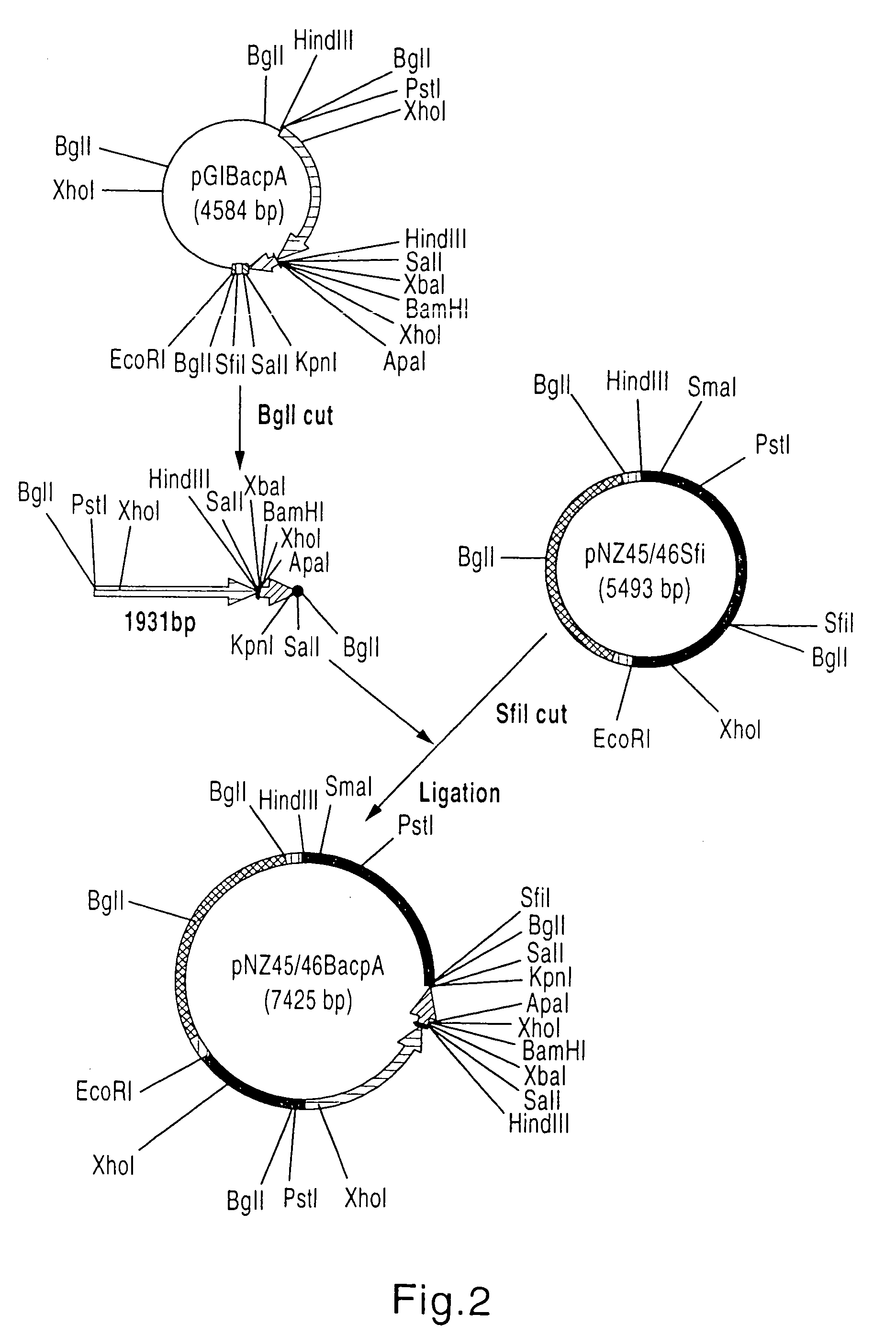Avian herpesvirus-based recombinant Infectious Bursal Disease vaccine
a technology of infectious bursal disease and avian herpesvirus, which is applied in the field of avian herpesvirus recombinant, can solve the problems of poor protective immunity of chicks, difficult prediction, and inflicting a great economic loss on the poultry industry, and achieve excellent protective immunity
- Summary
- Abstract
- Description
- Claims
- Application Information
AI Technical Summary
Benefits of technology
Problems solved by technology
Method used
Image
Examples
example 1
Preparation of VP2 cDNA from IBDV Delaware Variant E and STC Strains
1.1 Preparation of VP2 cDNA from IBDV Delaware Variant E strain
[0066]The Delaware Variant E strain, a serotype 1 IBDV (a gift from Biomune Company, Lenexa, Kans.) was inoculated into chickens. One week later, lysates of Bursa of Fabricius were prepared, which contained 105.32 EID50 / ml of IBDV. From these lysates, total viral RNA was isolated with Catrimox-14™ RNA Isolation Kit Ver2.11 (TaKaRa, Japan, Cat #WA005) under the conditions recommended by the supplier. The extracted total RNA was then subjected to RT-PCR using BcaBEST™ RNA PCR kit Ver.1.1 (TaKaRa, Japan, Cat. #RR023A). In the RT-PCR operation VP2-3R primer (SEQ ID NO. 4) and BcaBEST polymerase were used for reverse transcription, and primers VP2-3-1 (SEQ ID NO. 5), VP2-5-1 (SEQ ID NO. 6) and Bca-Optimized Taq polymerase for cDNA synthesis.
[0067]
VP2-3R (SEQ ID NO. 4)5′-CTACACCTTCCCCAATTGCATGGGC-3′VP2-3-1 (SEQ ID NO. 5)5′-GGTGGGAACAATGTAGAGACCACCGG-3′VP2-5-1 ...
example 2
Isolation of the Chick Beta-actin Promoter Gene
[0080]Using cellular DNA of CEF cells as a template amplified 1.5 kb DNA containing the chicken beta-actin promoter was obtained by PCR. PrBac1 (SEQ ID NO. 18) and PrBac2 (SEQ ID NO. 19) were the primer set used for PCR. The obtained DNA was digested with PstI and XbaI and inserted into pUC18. The sequence of the inserted DNA was determined as described before and confirmed to be that of the beta-actin promoter which was 1.525 bp long (SEQ ID NO. 3).
[0081]
PrBac1 (SEQ ID NO. 18)5′-CAGTGTCGCTGCAGCTCAGTGCATGCACGCTCATTGCCC-3′PrBac2 (SEQ ID NO. 19)5′-GCTCTAGAGTCGACAAGCTTGGGGGCTGCGGAGGAACAGAGAAGGGAAG-3′
example 3
Construction of Homology Vectors
3.1. Construction of Plasmid pGIBacpA
[0082]A DNA adapter consisting of synthetic oligonucleotides Ad-B-A-U (SEQ ID NO. 20) and Ad-B-A-L (SEQ ID NO. 21) was inserted between BamHI and ApaI sites of pGIMCSpolyASfi (2.773 bp WO 99 / 18215) to generate plasmid pGIMCS2 (2.765 bp).
[0083]
DNA adapter5′-GATCCCCTCGAGGGGGGGCC-3′ 3′-GGGAGCTCCCCC-5′
[0084]Plasmid pGIMCS2 was then digested with PstI and XbaI and ligated with the beta-actin promoter described in EXAMPLE 2 to give plasmid pGIBac (4.272 bp).
[0085]Next, using pBK-CMV (STRATAGENE, Cat. #212209) as a template and PolyA-F (SEQ ID NO. 22) and PolyA-R (SEQ ID NO. 23) as a set of primers. DNA including SV40 polyA signal was amplified by PCR. Digestion of the amplified DNA with ApaI and KpnI gave a 334 bp SV40 polyA signal DNA. The DNA was then inserted into pGIBac, which had been digested with ApaI and KpnI, to generate pGIBacpA (4,584 bp, FIG. 1).
[0086]
PolyA-F (SEQ ID NO. 22)5′-GCGGGCCCTAATTGTTTGTGTATTTTAG-...
PUM
| Property | Measurement | Unit |
|---|---|---|
| stability | aaaaa | aaaaa |
| length | aaaaa | aaaaa |
| genome structures | aaaaa | aaaaa |
Abstract
Description
Claims
Application Information
 Login to View More
Login to View More - R&D
- Intellectual Property
- Life Sciences
- Materials
- Tech Scout
- Unparalleled Data Quality
- Higher Quality Content
- 60% Fewer Hallucinations
Browse by: Latest US Patents, China's latest patents, Technical Efficacy Thesaurus, Application Domain, Technology Topic, Popular Technical Reports.
© 2025 PatSnap. All rights reserved.Legal|Privacy policy|Modern Slavery Act Transparency Statement|Sitemap|About US| Contact US: help@patsnap.com



